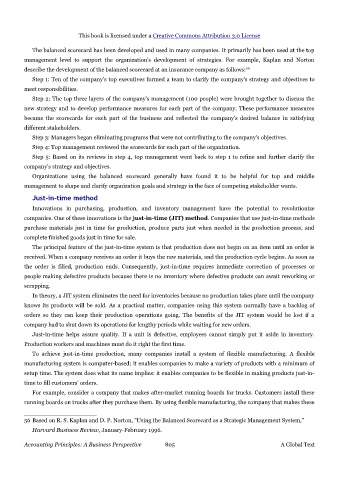Page 804 - Accounting Principles (A Business Perspective)
P. 804
This book is licensed under a Creative Commons Attribution 3.0 License
The balanced scorecard has been developed and used in many companies. It primarily has been used at the top
management level to support the organization's development of strategies. For example, Kaplan and Norton
describe the development of the balanced scorecard at an insurance company as follows: 56
Step 1: Ten of the company's top executives formed a team to clarify the company's strategy and objectives to
meet responsibilities.
Step 2: The top three layers of the company's management (100 people) were brought together to discuss the
new strategy and to develop performance measures for each part of the company. These performance measures
became the scorecards for each part of the business and reflected the company's desired balance in satisfying
different stakeholders.
Step 3: Managers began eliminating programs that were not contributing to the company's objectives.
Step 4: Top management reviewed the scorecards for each part of the organization.
Step 5: Based on its reviews in step 4, top management went back to step 1 to refine and further clarify the
company's strategy and objectives.
Organizations using the balanced scorecard generally have found it to be helpful for top and middle
management to shape and clarify organization goals and strategy in the face of competing stakeholder wants.
Just-in-time method
Innovations in purchasing, production, and inventory management have the potential to revolutionize
companies. One of these innovations is the just-in-time (JIT) method. Companies that use just-in-time methods
purchase materials just in time for production, produce parts just when needed in the production process, and
complete finished goods just in time for sale.
The principal feature of the just-in-time system is that production does not begin on an item until an order is
received. When a company receives an order it buys the raw materials, and the production cycle begins. As soon as
the order is filled, production ends. Consequently, just-in-time requires immediate correction of processes or
people making defective products because there is no inventory where defective products can await reworking or
scrapping.
In theory, a JIT system eliminates the need for inventories because no production takes place until the company
knows its products will be sold. As a practical matter, companies using this system normally have a backlog of
orders so they can keep their production operations going. The benefits of the JIT system would be lost if a
company had to shut down its operations for lengthy periods while waiting for new orders.
Just-in-time helps assure quality. If a unit is defective, employees cannot simply put it aside in inventory.
Production workers and machines must do it right the first time.
To achieve just-in-time production, many companies install a system of flexible manufacturing. A flexible
manufacturing system is computer-based; it enables companies to make a variety of products with a minimum of
setup time. The system does what its name implies: it enables companies to be flexible in making products just-in-
time to fill customers' orders.
For example, consider a company that makes after-market running boards for trucks. Customers install these
running boards on trucks after they purchase them. By using flexible manufacturing, the company that makes these
56 Based on R. S. Kaplan and D. P. Norton, "Using the Balanced Scorecard as a Strategic Management System,"
Harvard Business Review, January-February 1996.
Accounting Principles: A Business Perspective 805 A Global Text

